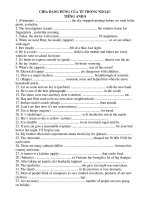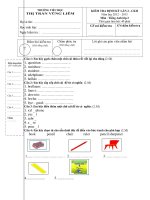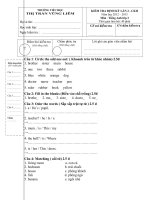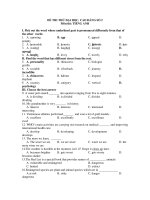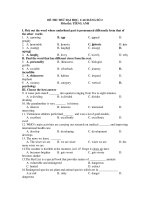WORLD ENGLISHES 2 (Đa dạng Tiếng Anh)
Bạn đang xem bản rút gọn của tài liệu. Xem và tải ngay bản đầy đủ của tài liệu tại đây (1.95 MB, 90 trang )
WORLD ENGLISHES
PHAN, THE HUNG
Ph.D. in Linguistics
Why English? The historical context
• geo-historical
• socio-cultural
• combination of these two strands
➔many varieties, in its use of sounds,
grammar, and vocabulary, and the
implications of this
Geo-historical
• The movement of English around the world:
➔pioneering voyages to the Americas, Asia, and the
Antipodes (Australia- New Zealand).
➔an expansion with the 19th-century colonial developments
in Africa and the South Pacific, and adopted in the mid 20th
century as an official or semi-official language by many newly
independent states.
➔English now represented in every continent, and in islands of
the three major oceans – Atlantic (St Helena), Indian
(Seychelles) and Pacific (in many islands, such as Fiji and
Hawaii).
➔the application of the label ‘global language’ a reality.
Socio-cultural
• People all over the world, in many walks of life, have
come to depend on English for their economic and
social well-being.
➔English penetrated deeply into the international
domains of political life, business, safety,
communication, entertainment, the media and
education
➔The convenience of having a lingua franca
(English) available to serve global human relations and
needs appreciated by millions
Origins
English arrived in England from northern Europe, in
the 5th century, spread around the British Isles.
• English entered parts of Wales, Cornwall, Cumbria
and southern Scotland, traditionally the strongholds
of the Celtic languages.
• After the Norman invasion of 1066, many nobles from
England fled north to Scotland, and eventually
English (in a distinctive Scots variety) spread
throughout the Scottish lowlands.
• From the 12th century, Anglo-Norman knights were
sent across the Irish Sea, and Ireland gradually fell
under English rule.
•
(cont.)
• The number of mother-tongue English speakers in
the world between 5 and 7 million, almost all of them
living in the British Isles.
• Between Elizabeth I (1603) and Elizabeth II (1952),
this figure increased almost fifty fold, to some 250
million, the vast majority living outside the British
Isles.
• Most of these people were Americans, and in
16th-century, North America being added to the
history of the language
America
• The first permanent English settlement dates from
1607, in Chesapeake Bay. The colonists called their
settlement Jamestown (after James I) and the area
Virginia (after the ‘Virgin Queen’, Elizabeth).
• In 1620, the first group of Puritans arrived on the
Mayflower in and established a settlement at what is
now Plymouth, Massachusetts.
➔a land for a new religious kingdom, free from
persecution and ‘purified’ from the church practices. By
1640 about 25,000 immigrants
(cont.)
• The two settlements – one in Virginia, to the south, the other to
the north, in present-day New England – had different
linguistic backgrounds.
• Although the southern colony brought settlers from
several parts of England, many of them came from
England’s ‘West Country’ and brought with them its
characteristic accent, with its ‘Zummerzet ’voicing of s sounds,
and the r strongly pronounced after vowels.
• By contrast, many of the Plymouth colonists came from
counties in the east of England (Lincolnshire,
Nottinghamshire, Essex, Kent and London. ➔These eastern
accents were rather different – notably, lacking an r after vowels
– and not to pronounce the r’ is still a feature of the speech of
people from New England.
(cont.)
• The later population movements across America largely
preserved the dialect distinctions.
• The New England people moved west into the region
of the Great Lakes; the southerners moved along the
Gulf Coast and into Texas; and the Midlanders spread
through out the whole of the vast, mid-western area
(Westward).
• The dialect picture with the main divisions of north,
midland, and south are still found throughout
America today
(cont.)
• During the 17th century, new immigrants brought an
increasing variety of linguistic backgrounds into the
country. Pennsylvania, for example, by Quakers
mostly from the Midlands and the north of England.
• In the 18th century, a vast wave of immigration from
northern Ireland with Irish and Scots-Irish
immigrants. By the time independence (1776) in
USA, about one in seven of the colonial population
was Scots-Irish
Languages Influenced English in USA
• not only England which influenced English in USA.
➔The Spanish in the west and south-west.
➔The French in the northern territories, around the St Lawrence
River, and throughout the middle regions (French Louisiana) as far as
the Gulf of Mexico.
➔The Dutch in New York (originally New Amsterdam) and the
surrounding area.
➔ Large numbers of Germans began to arrive at the end of the 17th
century, settling mainly in Pennsylvania and its hinterland.
➔Increasing numbers of Africans entering the south, as a result of the
slave trade in the 18th century:
➔According to the 1990 census, the number of people (over five
years of age) who spoke only English at home had grown to over
198million–86 percent of the population. This figure increased to
215 million in the 2000 census (though representing a fall to 82 per
cent of the population).
English in Canada
• The first English-language contact with Canada was
as early as 1497; but English migration along the
Atlantic coast did not develop until a century later,
when the farming, fishing, and fur trading industries
attracted English-speaking settlers
• A conflict with the French, whose presence dated
from the explorations of Jacques Cartier in the 1520s
• The numbers were then further increased by many
coming directly from England, Ireland, and Scotland
(whose earlier interest in the country is reflected in the
name Nova Scotia ‘New Scotland’).
(cont.)
• The next major development followed the US Declaration
of Independence in 1776.
➔Loyalist supporters of Britain (the ‘United Empire Loyalists’)
found themselves unable to stay in the new United States, and
most left for Canada. Within fifty years, the population of this
province had reached 100,000. Over 31 million were estimated
in 2001, with two-thirds claiming English as a native or home
language.
➔Because of its origins, Canadian English has a great deal
in common with the rest of the English spoken in North
America
➔Many British people identify a Canadian accent as American;
many Americans identify it as British.
➔In addition, the presence of French as a co-official language,
chiefly spoken in Quebec, produces a sociolinguistic situation
not found in other English-speaking countries
The Caribbean
• Early 17th century, ships from Europe travelled to the West
African coast, for exchanging cheap goods for black slaves
shipped in barbarous conditions to the Caribbean islands and
the American coast
• The policy of the slave-traders was to bring people of different
language backgrounds together in the ships, to make it difficult
for groups to plot rebellion ➔the growth of several pidgin
forms of communication, and in particular a pidgin between
the slaves and the sailors, many of whom spoke English
• Once arrived in the Caribbean, this pidgin English continued
to act as a means of communication between the black
population and the new land owners, and among the blacks
themselves.
Pidgins & Creoles
• Pidgin, originally, a language that typically developed out of sporadic
and limited contacts between Europeans and non-Europeans in
locations other than Europe from the 16th through the early 19th
century and often in association with activities such as trade,
plantation agriculture, and mining.
• Typical pidgins function as lingua francas, or means for
intergroup communication
• Pidgin English is a non-specific name used to refer to any of the
many pidgin languages derived from English. Pidgins that are spoken
as first languages become creoles.
• English-based pidgins that became stable contact languages
(cont.)
• Some of the pidgins that have survived for several
generations are also spoken as vernaculars by some of
their users, including Nigerian Pidgin, Cameroon
Pidgin, Tok Pisin (Papua New Guinea), and
Bislama (Vanuatu), all of which are based on a
predominantly English vocabulary.
• Such vernaculars have developed systems as complex
as those of related creoles and are called expanded
pidgins
